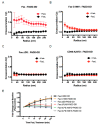Super-Resolution Imaging of Fas/CD95 Reorganization Induced by Membrane-Bound Fas Ligand Reveals Nanoscale Clustering Upstream of FADD Recruitment
- PMID: 35741037
- PMCID: PMC9221696
- DOI: 10.3390/cells11121908
Super-Resolution Imaging of Fas/CD95 Reorganization Induced by Membrane-Bound Fas Ligand Reveals Nanoscale Clustering Upstream of FADD Recruitment
Abstract
Signaling through the TNF-family receptor Fas/CD95 can trigger apoptosis or non-apoptotic cellular responses and is essential for protection from autoimmunity. Receptor clustering has been observed following interaction with Fas ligand (FasL), but the stoichiometry of Fas, particularly when triggered by membrane-bound FasL, the only form of FasL competent at inducing programmed cell death, is not known. Here we used super-resolution microscopy to study the behavior of single molecules of Fas/CD95 on the plasma membrane after interaction of Fas with FasL on planar lipid bilayers. We observed rapid formation of Fas protein superclusters containing more than 20 receptors after interactions with membrane-bound FasL. Fluorescence correlation imaging demonstrated recruitment of FADD dependent on an intact Fas death domain, with lipid raft association playing a secondary role. Flow-cytometric FRET analysis confirmed these results, and also showed that some Fas clustering can occur in the absence of FADD and caspase-8. Point mutations in the Fas death domain associated with autoimmune lymphoproliferative syndrome (ALPS) completely disrupted Fas reorganization and FADD recruitment, confirming structure-based predictions of the critical role that these residues play in Fas-Fas and Fas-FADD interactions. Finally, we showed that induction of apoptosis correlated with the ability to form superclusters and recruit FADD.
Keywords: CD95; Fas; PALM imaging; TNFR superfamily; receptor signaling; super-resolution microscopy.
Conflict of interest statement
R.M.S. is currently an employee of Novartis and owns Novartis stock.
Figures




Similar articles
-
Fas-associated death domain protein and caspase-8 are not recruited to the tumor necrosis factor receptor 1 signaling complex during tumor necrosis factor-induced apoptosis.J Biol Chem. 2003 Jul 11;278(28):25534-41. doi: 10.1074/jbc.M303399200. Epub 2003 Apr 29. J Biol Chem. 2003. PMID: 12721308
-
Involvement of raft aggregates enriched in Fas/CD95 death-inducing signaling complex in the antileukemic action of edelfosine in Jurkat cells.PLoS One. 2009;4(4):e5044. doi: 10.1371/journal.pone.0005044. Epub 2009 Apr 7. PLoS One. 2009. PMID: 19352436 Free PMC article.
-
Edelfosine and perifosine induce selective apoptosis in multiple myeloma by recruitment of death receptors and downstream signaling molecules into lipid rafts.Blood. 2007 Jan 15;109(2):711-9. doi: 10.1182/blood-2006-04-016824. Epub 2006 Sep 26. Blood. 2007. PMID: 17003375
-
The role of the Fas/FasL signaling pathway in environmental toxicant-induced testicular cell apoptosis: An update.Syst Biol Reprod Med. 2018 Apr;64(2):93-102. doi: 10.1080/19396368.2017.1422046. Epub 2018 Jan 4. Syst Biol Reprod Med. 2018. PMID: 29299971 Review.
-
Regulation of CD95/Fas signaling at the DISC.Cell Death Differ. 2012 Jan;19(1):36-41. doi: 10.1038/cdd.2011.155. Epub 2011 Nov 11. Cell Death Differ. 2012. PMID: 22075988 Free PMC article. Review.
Cited by
-
The benefits of clustering in TNF receptor superfamily signaling.Front Immunol. 2023 Aug 17;14:1225704. doi: 10.3389/fimmu.2023.1225704. eCollection 2023. Front Immunol. 2023. PMID: 37662920 Free PMC article. Review.
-
TNF-Related Apoptosis-Inducing Ligand: Non-Apoptotic Signalling.Cells. 2024 Mar 16;13(6):521. doi: 10.3390/cells13060521. Cells. 2024. PMID: 38534365 Free PMC article. Review.
-
FAS gene expression, prognostic significance and molecular interactions in lung cancer.Front Oncol. 2024 Oct 2;14:1473515. doi: 10.3389/fonc.2024.1473515. eCollection 2024. Front Oncol. 2024. PMID: 39416461 Free PMC article.
-
HSV-1 hijacks mitochondrial dynamics: potential molecular mechanisms linking viral infection to neurodegenerative disorders.Apoptosis. 2025 Jul 1. doi: 10.1007/s10495-025-02142-9. Online ahead of print. Apoptosis. 2025. PMID: 40593393 Review.
-
RNA-Sequencing Characterization of lncRNA and mRNA Functions in Septic Pig Liver Injury.Genes (Basel). 2023 Apr 20;14(4):945. doi: 10.3390/genes14040945. Genes (Basel). 2023. PMID: 37107704 Free PMC article.
References
-
- Wang L., Yang J.K., Kabaleeswaran V., Rice A.J., Cruz A.C., Park A.Y., Yin Q., Damko E., Jang S.B., Raunser S., et al. The Fas-FADD death domain complex structure reveals the basis of DISC assembly and disease mutations. Nat. Struct. Mol. Biol. 2010;17:1324–1329. doi: 10.1038/nsmb.1920. - DOI - PMC - PubMed
-
- Stranges P.B., Watson J., Cooper C.J., Choisy-Rossi C.M., Stonebraker A.C., Beighton R.A., Hartig H., Sundberg J.P., Servick S., Kaufmann G., et al. Elimination of antigen-presenting cells and autoreactive T cells by Fas contributes to prevention of autoimmunity. Immunity. 2007;26:629–641. doi: 10.1016/j.immuni.2007.03.016. - DOI - PMC - PubMed
Publication types
MeSH terms
Substances
Grants and funding
LinkOut - more resources
Full Text Sources
Research Materials
Miscellaneous

